|
|
The Teide National Park in the core of the island Tenerife
An absolutely highlight and therefore also a must for every visitor of Tenerife is a visit to the national park of the Teide, the Parque Nacional de Las Caņadas del Teide. I personally liked this national park so much that I straght visited it twice. Thus, the following pictures are of two different tours, as it is easily recognizable from the pictures of the peak. A visit to the national park of the Teide is always a one day excursion, even if one does not do any hiking. Because crossing the whole national park equals a complete round trip of the island. In total, four roads lead up to the national park: from the north, two roads lead from Puerto de la Cruz and from La Laguna up to the national park. From the south, two roads meet in the national park - one from Vilaflor and one from Guía de Isora and/or Chío. 
On the road from Vilaflor, one serpentine follows the next; Vilaflor is already located at a height of 1160 m. Either the street up to Vilaflor as also up to the national park, it is very unpleasant to drive. It takes very long and the own stomach makes one understand that it is also having holidays... The road from Puerto de la Cruz is also not spectacular. Thus, the best route one can drive is by crossing the whole island, which means from Guía de Isora to La Laguna and/or the way around. This route is approximately 100 km long; the roads are very well arranged and thus they are very nice to drive. As for such a tour, really one full day is to be scheduled, it is nice if one can afterwards drive comfortably on the motorway back to the home place. Have good fun during the day tour through the Teide national park. We start at Guía de Isora. Start at the early morningNo matter from which point of the island one starts, one is always in maximum two hours in the national park of the Teide. But anyhow, the time one starts has a decesive role. High mountains are known for their short termed influence on the weather. Typically, in the mornings at the high mountains when the air is still cold and the rock faces are still not heated by the sun, it is crystal clear, while in the afternoon fleecy clouds are formed. 

During my first tour, when I arrived at the top in the afternoon, the Teide was already covered by a little hood that did not want to disappear. During the second tour, I first convinced myself in the morning dawn that there was no clowd at the top. And that was left for say was: into the car and up to the national park. But there is another reason why one should start early (before 8 o'clock): between 8 and 9 in the morning, the big travel busses start to drive to the national park. They take daily several thousands of tourists form all spots of the island to this gorgeous place. Of course, the buses provide traffic jam on the roads; but it is also unpleasant at the view points if there are hundreds of people around oneself and there is to queue in order to get a free position for the camera. The trip to the national parkThose who think now that the trip to the national park is something monoton that has rapidly to get over with in order to enjoy the national park itself, i will disabuse now. Finally, one starts its trip at a sea height of 0 metres and then drives up to a 2300 metres height. The fact that in this stretch, one experiences all kinds of vegetation in a fast motion should make sense. 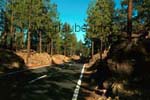

The trip up to Guía de Isora is really only rapidly get over full of expectation. In the next little place named Chío the permanent rise begins at 600 metres to the top. While at the beginning everything is green and colourful, it doesn't take much to find oneself in the huge stone pine and pine forests. The road partly leads straightaway through the forests. The landscape seems to be simply endless, but the spectacles of colours consisting on a blue sky, green trees, brown rocks and grey road is absolutely fascinating and seems at first to be endless. 
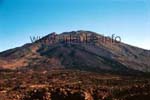
As the road is pretty straight, one soon covers the distance. Finally, one leaves the dense pine forests and the Montaņa de Abeque behind, from which it is possible to view the neighbour island La Palma in case of good weather conditions, and accesses the Parque Nacional del Teide. After the abundance of colours experienced in the pine forests, one is now in a lava area, were stones and the solidified lava masses dominate. Sporadically, the first pines grow from the fertile lava masses. If one drives on the road in the early morning, one is practically alone, so that it is possible to make some stops on the road in order to take some pictures. The Mirador de Chio is the official rest area and view point at a height of more than 2100 m. Here, pithc-black lava masses are originated as they were stockpiled there. One continuously sees the peak of the Teide that will be rounded form the southern side. Las CaņadasDuring our trip we finally arrived to the elevated plain of Caņadas, that is extended on heights between 1900 m and 2300 m. With a size of 16 km x 10 km, the huge crater kettle (calle de caldera) from the main component of the Parque Nacional del Teide that was arranged in the year 1954. The Caldera is limeited at the south by the Montaņa de las Caņadas, in the north by the Teide itself and the Montaņa Blanca. 

The Caldera of Caņadas was originated approximately 170.000 years ago, when some mighty landslides in the north of the island rushed into the sea. From the former round kettle, todsy only remained the southern basin that has the form of a horseshoe, as numerous eruptions in the north fille dup the Caldera in the course of the years. In the Caņadas, nearly every day the sun shines, the limit of the clowd of the tradewind is approximately at 1700 metres. As a visitor of the Parque Nacional of Las Caņadas del Teide, one experiences a varied wonder of nature. Solidified magma rivers, wildly piled ash dumps, feather-edged boulder, polished cinder fields, and tongues of lava metres high put the visitor into an apparent, vietual world that is only known from science fiction filmen kennt. Additionally, there are the moonscapes, places like deserts, rocks shining in red and yellow colours - an indiscribable pectacle of colours and formations. Not only the nature and the rocks are fascinating, but also the only thing that one can drive for kilometrres on a surface that is more than 200 metres high. Roques de GarciaAfter having driven some kilometres in the Caņadas, one gets close to the Parador Nacional de las Caņadas to an absolute highlight of the tour, the Roques de Garcia or simply: Los Roques. The Parador Nacional de las Caņadas is, by the way, the hotel at the highest altitude of the Canarian Islands, with an own pool, a very good restaurant and of course a unique atmosphere. 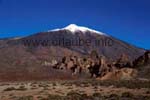

The Roques de Garcia are about a very bizarr and unique rock formation. On a height of approximately 1000 metres, some spicular rocks of different colours string together. The rocks consist on different stone coats of different eruptions that also erode in a different speed. As the softer coats are underneath, in the course of millions of years, one rock will cave in after the other. Of course, the rocks get really spectacular when the gorgeos Teide radiates in the background. 
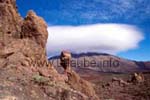
The most famous rock of Roques de Garcia is the Roque Cinchado, where the different rock coats are best recognizable. It is obvious that one day, this rock will cave in under its current narrow fundament. From the parking place of Roques de Garcia one can go up for approximately 50 metres to the height in a locked area. From there, one is rewarded with a fantastic view to the Llano de Ucanca (Ucanca lowlands). At a glance one cann see the distance one has already traveld in the national park; also, one sees a major part of the Montaņa de Las Caņadas at once; and one has a breathtaking view to the majestically appearing Teide. The Pico del TeideAfter the visit of the Roques de Garcia, the most spectacular part of the round trip through the national park of the Teide is behind one. Normally, the next station is the funicular station at a height of 2350 m. The Teleférico takes the visitors in less than 10 minutes to a height of 3550 m up to the mountain station La Rambleta. But the fubicular only works if the weather is fine and not in the winter when it has too much ice and neither in the month of May when the maintenance is done. 

The experience of a driveway with the funicular is normally taken away; but those who have the bad luck that the funicular is closed due to one of the already mentioned reasons does not need to be frustrated. It is not missed much, as one is only taken to an observation deck. Thus, for ascending to the top, a special permission is needed. For many visitors of the Teide, the 2300 m height of the national park already means a challenge for the health. The fast ascension to more than 3500 m height rapidly leads to cardiovascular problems. This is why first of all one has to get used of the mountain air before having the trip with the funicular. Those who do not arrive in time to the funicular station has to wait in any case up to 3 hours. As one is only taken to the mountain station La Rambleta at a height of 3550 m, but the crated edge is at a height of 3718 m, one has "only" a breathtaking view to the Montaņa de Las Caņadas. As normally one has back light it is not even possible to take some nice pictures. The way back up to La LagunaActually, now one has seen everything: the Teide itself, the famous Los Roques, the plateau Caņadas, the most different types of landscapes etc. Now, there are still approximately 50 km to La Laguna and the tour is finished. But from the funicular station, it takes at least half an hour until one makes the definite departure. During this way one has sights that are at least as breathtaking as those that are left behind. 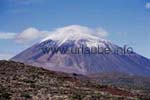
First, the trip through the plateau offers numerous view points from which on one hand, one can see the Teide form different sides and on the other hand, one can see some rare moonscapes, desert areas and rock formations. Shortly before the road bifurcates there is the visitors center. In the Centro de Visitantes one is informed in a little tour a lot about the origin of Tenerife and the whole Canarian archipielago and of course about the most recent history of the island itself. 
The road leads at the left to a very unatractive and uncomfortable way to Puerto de la Cruz. At the right, it leads again 200 m up to the observatory. There, one can get informed about the work of the astronomers. But one gets much more out by looking from there again to the Teide. (see both pictures). 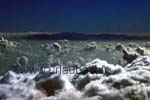
A few kilometres later, the city Purto de la Cruz is visible form a height of 2000 metres (see picture in the respective pege). And those who are very lucky gets at the right an unforgettable view over the clowd cover of the tradewind up to the neighbour island Gran Canaria that is approximately 70 kilometres away. My picture can not represent at all this view due to the sun rays. But those who enjoy such a view by themselves, they will also have the picture saved in their minds for a long time. Finally one reappears in the pine forest and after one hour one gets to La Laguna, where there is straight the motorway. I hope you enjoyed the tour through the national park of el Teide! Copyright: Patrick Wagner, www.tourist-guide.biz |
||
